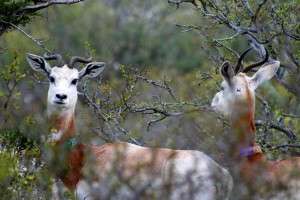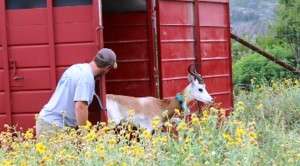Second phase of dama gazelle study will focus on social interactions

In a second phase of research, scientists from Second Ark Foundation and Texas A&M AgriLife Research are again collaborating—this time to find out more about the social interactions of dama gazelles.
Dr. Elizabeth Cary Mungall, science officer for the Second Ark Foundation in Ingram, and Dr. Susan Cooper, an AgriLife Research wildlife ecologist at the Texas A&M AgriLife Research and Extension Center in Uvalde, are again collecting data to help ensure the survival of this endangered species.
The dama gazelle, the largest and rarest of all gazelles, is listed on the International Union for Conservation of Nature Red List for Threatened Species as critically endangered. Recent estimates are that only about 300 remain wild in their native habitat of sub-Saharan Africa.
"There are currently more dama gazelles on ranches in the U.S., primarily in Texas, than there are in the wild and in zoos throughout the world," said Mungall, who has been working for several years to help rebuild the dama gazelle population so more of the animals might be reintroduced to their native Africa.
Environmental conditions experienced by dama gazelles in this semi-arid Hill Country region of Texas are probably as close as can be found within the U.S. to their native African habitat, she said.
In previous research, the two worked with Stevens "Steve" Forest, owner of Stevens Forest Ranch near the West Texas town of Dryden, to study the range use of dama gazelles on his approximately 22,000-acre wildlife pasture.
In the next phase, they will work with Cole and Kevin Reid of Morani River Ranch near Uvalde to learn more about dama gazelle social interactions and how these may affect their ability to reproduce and survive. Morani River Ranch is a 3,000-acre property located in the Texas Hill Country. According to its website, the ranch is "dedicated to the preservation and proliferation of wildlife and its habitat." Research will be conducted on a 500-acre pasture on ranch property.
In addition to the Second Ark Foundation, AgriLife Research and the Morani River Ranch, major support for this new phase of research is being coordinated through the Exotic Wildlife Association and Bisbee's Fish and Wildlife Conservation Fund, along with Fossil Rim Wildlife Center.

Mungall said important information on the social order and interactions of dama gazelles in their native habitat is not well known due to the rarity of the species within its African distribution. There is also the difficulty of working in the semi-desert southern fringe of the Sahara which is home to the animal.
"Unlike other endangered desert ungulates, such as the scimitar-horned oryx and addax, which have been transplanted from Africa to Texas, dama gazelles have proved more difficult to establish in captive breeding programs," Mungall said. "A major problem encountered by those attempting to establish breeding herds of dama gazelles for purposes of conservation and reintroduction is aggression among males.
"In captivity, males use their horns, which are not very long but can still be deadly, to inflict damage upon or even kill rivals if there is not adequate space for them to escape. We need to know more about the social organization or social order of this species and what the challenges may be in more limited areas."
Cooper, who provided her technical expertise gained from tracking white-tailed deer in South Texas to the first phase of this research, was again asked to apply this expertise to gather data for the second phase.
"As we did in the first phase of our research, we placed GPS collars on the subject animals to determine how and where they gather and what their social interactions may be," Cooper said. "We are especially interested in whether the females group together with one male or distribute themselves among different males, as well as how adult males react to other adult males and subadult males, especially in more limited spaces. It's important to have this information to determine the optimal group sizes and distributions for the animals when they are reintroduced to their native habitat."
The previous research had shown male dama gazelles to have an exclusive-use core area of approximately 1,000 acres within a home range of more than 3,000 acres. These adult males tended to stay about 1.5 miles apart, but their reaction to other adult males or subadult males entering their territory is still unknown.
"In data gathered from the first phase of the research, we noted that even though the outer bands of their home ranges overlapped, there was only limited contact between adult male dama gazelles," she said. "In this next phase, they will be monitored in a smaller pasture size that is more typical of the size where they are breeding in Texas. Combined with information from the previous study, this will give a better idea of how the animals might react under various different conditions for possible reintroduction."
For conservation of the species, it is important that dama gazelles succeed in Texas as well as succeed in their reintroduction efforts, Mungall said.
With the help of personnel from the Morani River Ranch and Second Ark Foundation to hold and sedate the animals, Cooper and Shane Sieckenius, an AgriLife Research assistant at the Uvalde center, and AgriLife Research technician Andrea Silva, tracking collars were fitted on a social mix of subject animals. Three adult males, seven females and one subadult male dama gazelles were identified for the study.
The collars have a GPS unit built into the top and a battery box on the bottom, along with an antenna built into one side of the collar. On the other side of the collar is a built-in timed drop-off unit that releases the collar automatically after a set time. The collars were programmed to record the location of the animal once every three hours for an entire year.
Information from this phase of research and the previous phase is needed for to help establish stocking rates for conservation reserves and ranches, and to determine minimum pasture sizes for effective multi-male captive breeding groups.
"Once we learn how these animals interact, we can apply this knowledge to help the species both here and in any potential restocking efforts to reintroduce them to their native African habitat," she said. "This data will help us better understand social interaction and breeding patterns and how we might determine the optimum circumstances for reintroduction and reproduction so they can be more successful."
She said the current standard Texas Hill Country "model" is to keep only single-male herds, but this study will help determine other possibilities for managing and increasing the species.
"Maintaining a second breeding group within sight but physically separated by fences appears to increase reproductive output," Mungall said. "And since competition between males seems to increase breeding, a site with ample space for multiple males to coexist without excessive fighting may be a better management option for successful establishment of productive herds of dama gazelles."
Provided by Texas A&M University



















